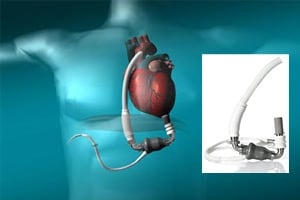
The HeartMate II left ventricular assist device has been associated with a deep spike in thrombosis (blood clot) risk, according to just-published research into the cardiac device. The HeartMate II, which is manufactured by Thoratec Corporation, has been associated with a significant increase in blood clot rates in patients implanted with the device, according to […]
 The HeartMate II left ventricular assist device has been associated with a deep spike in thrombosis (blood clot) risk, according to just-published research into the cardiac device.
The HeartMate II left ventricular assist device has been associated with a deep spike in thrombosis (blood clot) risk, according to just-published research into the cardiac device.
The HeartMate II, which is manufactured by Thoratec Corporation, has been associated with a significant increase in blood clot rates in patients implanted with the device, according to a New England Journal of Medicine (NEJM) study published on November 27th, MassDevice.com reported. Shares of Thoratec Corp. dropped following publication of the NEJM study.
The HeartMate II is a cardiac device in the category of products known as left ventricular assist devices, or LVADs. The HeartMate II is made with a pump that pushes blood through the heart on a nonstop basis, The New York Times reported.
The researchers analyzed data from three centers—the Cleveland Clinic, the Washington University Barnes-Jewish Hospital, and Duke University Medical Center. The three locations implanted 895 HeartMate II LVADs in 837 patients from January 2004 through May 2013, MassDevice.com reported. Of these procedures, a total of 72 confirmed cases of pump thrombosis were discovered in 66 patients, and 36 additional suspected cases of pump thrombosis were also detected, according to the NEJM study.
“The occurrence of confirmed pump thrombosis increased steeply after approximately March 2011, from 2.2 percent … at 3 months after implantation to 8.4 percent,” the researchers wrote. “A similar pattern was observed at all three institutions and for multiple surgeons,” they added, according to the MassDevice.com report.
The research also pointed to a similarly sharp decline from when HeartMate II implantation occurred to when a blood clot developed—from 18.6 months to 2.7 months, according to MassDevice.com. Increased levels of lactate dehydrogenase (LDH) were also found to be followed by confirmed blood clot cases. This finding reveals that LDH levels might be considered a marker for HeartMate II thrombosis risks.
The researchers wrote that a build-up of both fibrin and a denatured protein that accumulates near the HeartMate II’s inflow bearing could be responsible, in part, for clot formation, according to the NEJM study.
In 2012, Cleveland Clinic physicians began seeing issues with the HeartMate II, according to The New York Times. The device is used to treat patients diagnosed with advanced heart failure; for instance, patients such as Vice President Dick Cheney. The number of patients developing thrombosis following HeartMate II implantation was rising and researchers wanted to understand why, reviewing hospital records earlier this year. The results were alarming, according to The New York Times.
The number of blood clots in HeartMate II patients implanted after March 2011 was almost four times greater than what was seen in those patients who were implanted with the device before March 2011, according to The New York Times. In patients who did not die, pump-related clots necessitated emergency measures and typically heart transplants or device replacements. “When we got the data, we said, ‘Wow,’” Dr. Randall C. Starling, a cardiologist at Cleveland Clinic, told The New York Times.
In a statement, the U.S. Food and Drug Administration (FDA) indicated that it was in the process of reviewing the study’s findings. “The agency shares the authors concerns about the possibility of increased pump thrombosis,” the agency indicated.


